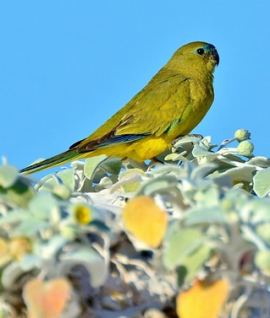Rock Parrot |
|
|
Also known as: Rock Grass-Parakeet, Rock Elegant Parakeet
Photos
View in GalleryDid You Know?
Allowing a Rock Parrot to become overweight in captivity can reduce its ability to breed successfully due to low fertility.Academic Research
Related publications: Neophema petrophilaSpecies Profile
Genus: Neophema | Species: petrophila
Size:
22cm (8.6 in)
Weight:
44-67g (1.5-2.3 oz)
Subspecies including nominate:
one
Colour Adult:
Both adults brown/olive crown and upperparts; wide dark blue frontal band, edged with pale blue above and below; face dull blue; breast dull olive; abdomen olive/yellow, sometimes suffused with orange in centre; bright yellow undertail coverts and undertail; bend of wing and outside lesser and secondary wing coverts soft purple/blue; pale blue middle secondary and lesser wing coverts; light underwing band. Bill dark grey. Eye dark brown.
Colour Juvenile:
As in adults but duller with front band or blue on face absent; pale underwing band present. Bill yellow/brown.
Call:
Call is said to be plaintive while bird is in flight, notes repeated frequently. While feeding emits occasional tittering notes.
Video Links:
Video 1More Information:
Content Sources:
CITES
BirdLife International
Cornell Lab of Ornithology/Birds of the World
Parrots: A Guide to Parrots of the World, Juniper and Parr, 1998
Parrots of the World, Forshaw and Cooper, 1977. 2010 edition
Parrots of the World, Forshaw, 2006.
Lexicon of Parrots, Thomas Arndt.
Photos
View in GalleryDid You Know?
Allowing a Rock Parrot to become overweight in captivity can reduce its ability to breed successfully due to low fertility.Academic Research
Related publications: Neophema petrophilaSpecies Care
Captive Status:
Somewhat common in Australia, not so elsewhere.
Longevity:
About 12 yrs.
Housing:
Walk-in aviary, minimum length 3m (9.8 ft). Prefers plants.
Diet:
Seed mix such as: canary, oats, safflower, niger, limited sunflower; spray millet; lots of green leaves such as: Swiss chard, lettuce, sowthistle, dandelion, chickweed; vegetables such as: carrot, celery, green peas in the pod and beans, zucchini; complete kibble.
Enrichment:
Planted aviary with many bird safe wood and leaf types, planted seeding grasses where possible, areas for bathing.
Nest Box Size:
12 x 12 x 25cm box (5" x 5" x 10").
Clutch Size:
4 or 5
Incubation Time:
18-19 days
Fledging Age:
4.5 weeks
Hatch Weight:
Not recorded.
Peak Weight:
Not recorded.
Weaning Weight:
Not recorded.
Photos
View in GalleryDid You Know?
Allowing a Rock Parrot to become overweight in captivity can reduce its ability to breed successfully due to low fertility.Academic Research
Related publications: Neophema petrophilaSpecies Wild Status
World Population:
Unknown, decreasing.
IUCN Red List Status:
Least Concern
CITES Listing:
Appendix II
Threat Summary:
Not globally threatened. Generally common, however, there is evidence of a population decline due to predation by invasive species such as rats, foxes, lizards and cats.
Range:
Coastal SW and S mainland Australia, including islands offshore.
Habitat:
Stays at or near sea level; breeds on small rocky offshore islets where their nests are relatively safe from predation. Also can be found in scrubby areas near the coast, in coastal grasslands, along estuaries, in mangroves and in sandy areas near the shore.
Wild Diet:
Diet includes seeds and fruits of grasses, shrubs and halophytic (salt-loving) plants including Carpobrotus aequilaterus and C. crystallinum, also Lepidium foliosum, Correa reflexa, Atriplex, Rhagodia, Arthrocnemum arbuscula and non-native Arctotheca nivea; have been known to take spilt wheat.
Ecology and Behaviour:
Large groups gather on the ground at abundant food sources; easily startled.
Clutch and Egg Size:
4 or 5 elliptical eggs, 24.0 x 19.5mm (0.9 x 0.7 in).
Breeding Season:
August-December, sometimes February. Nest is in crevice between seashore boulders or cliffs, and rarely in old seabird burrows.
Related Links:
Photos
View in GalleryDid You Know?
Allowing a Rock Parrot to become overweight in captivity can reduce its ability to breed successfully due to low fertility.Academic Research
Related publications: Neophema petrophilaMembers Only Resources
Please log-in now to find more research, resources and tools.
Not a Member?
Find more great information:
Gain exclusive access to 600+ pages of additional research, seminars and podcasts, specialists to ask your toughest questions, and dozens of other fun resources - when you become a WPT member.
Join Today >>

































